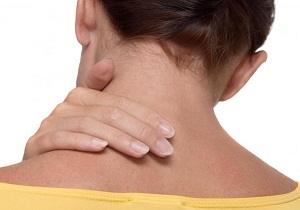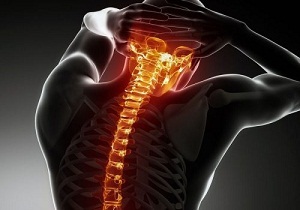
Many negative factors cause negative changes in the intervertebral discs - chondrosis develops. If left untreated, the disease progresses, degenerative and dystrophic processes affect bone tissue, osteophytes grow, osteochondrosis develops, and neck pain occurs.
Home treatment is a complex of different measures. It is important to stop the destruction of discs, eliminate inflammation and pain syndrome, and begin the process of regeneration of the elastic pads between the vertebrae. A good effect is given by a combination of chondroprotectors, muscle relaxants, NSAIDs with exercise, massage and other methods of influencing weakened structures.
Causes and symptoms of osteochondrosis
The disease is getting younger every year. A few decades ago, with signs of osteochondrosis of the spine, patients after 40-50 years turned to a vertebrologist for help, now many young people have a diagnosis of cervical osteochondrosis in their medical records. What is the reason?
Physical inactivity, prolonged use of computers with little or no movement in combination with endocrine pathologies, smoking, poor nutrition and poor ecology increase the risk of damage to intervertebral discs and bone structures. The destruction of cartilage begins much earlier than nature intended.
If earlier the main cause of cervical osteochondrosis was the process of natural aging (the pillow between the vertebrae received less food with age, became less elastic, became thinner), now there are many other negative factors.
Increase the risk of degenerative and dystrophic processes in the intervertebral discs and vertebral bodies:

- heavy loads on the support during hard work, in professional athletes, when carrying heavy bags, improper lifting technique;
- overweight;
- back and cervical injuries;
- endocrine diseases, hormonal disorders during menopause, pregnancy;
- irregular mineral metabolism, chronic pathologies associated with salt deposition, such as gout;
- heredity;
- lack of calcium, magnesium, phosphorus;
- excessive consumption of strong coffee for a long time, addiction to alcohol, narcotics, smoking;
- improper diet, vitamin deficiency: lack of nutrients reduces the speed and quality of cartilage feeding during diffusion;
- unwillingness to exercise: the poorer the flexibility of the spine, the weaker the muscular corset, the greater the risk of affecting all support pillar structures.
Important facts about cervical osteochondrosis:
- The disease goes through periods of remission and exacerbation. The more carefully the patient fulfills the doctor's recommendations, the lower the rate of degenerative processes, which slows down the transition from mild to moderate pathology to more severe;
- At an early stage, the person has no doubt that the process of degeneration in the pad has begun. The more negative factors acting, the more active the intervertebral discs are destroyed;
- Doctors warn:Overweight often occurs against the background of endocrine diseases and low physical activity, which increases the risk of cartilage damage. If an obese person smokes a lot, drinks coffee often, does hard work or sits at a computer / TV for a long time, then we can say with almost 100% certainty: chondrosis will quickly turn into osteochondrosis, bulges and intervertebral hernias will appear.
Signs and symptoms of cervical osteochondrosis:
- first stage - with a lack of nutrients, the elasticity of the cartilage lining is reduced, the height of the disc is slightly reduced, during exercise there is a slight pain in the back and neck;
- the more active the deformation of the intervertebral structures, the more often the discomfort worries, the greater the risk of disc destruction. When the fibrous ring ruptures, the friction of the bone structures increases, the nerve roots tighten and pain occurs. Pinched blood vessels negatively affect the nutrition of important parts of the brain. When sensitive structures and vessels are constricted, the nutrition of the brain deteriorates, headaches are disturbed, vision is reduced, dizziness and nausea appear;
- in the third stage of osteochondrosis, the integrity of the ring fibrosis is disturbed, the friction of the bone elements increases, frequent pains are disturbed, hernias develop (there is a bulging disc). Without the use of NSAIDs and analgesics, the pain syndrome complicates the patient's life;
- if you do not consult a doctor, then osteochondrosis will progress to a fourfold, most severe stage. The pillowcase is practically destroyed, the mobility of the spine is reduced. The body tries to compensate for the almost complete absence of elastic discs, osteophytes grow - growths that reduce the force of pressure on the vertebrae and nerve roots. There is a stabilization of the supporting pillar, the pain is weak, but at the same time the mobility of the spine in the cervical zone is reduced, it is difficult for a person to move, bend, turn, bend the head. The patient often receives a disability group. In severe cases, surgery may be needed to fix the weakened vertebral structures with special plates.

Note!In the first-third degree of cervical osteochondrosis, therapy can be carried out without hospitalization. In advanced cases, acute pain syndrome is required in patients with stage IV disease, observation at a vertebrological center, or surgery in the neurosurgery department.
Home treatment
How to treat cervical osteochondrosis? Therapy will be successful if the following rules are followed:
- start therapy only after visiting a vertebrologist or orthopedic traumatologist;
- take medication prescribed by a doctor;
- perform complex exercise therapy;
- do massage and self-massage problem areas;
- use folk remedies approved by a doctor;
- properly equip a place to work and sleep: orthopedic mat or shield under a regular mattress, low pillow.
Important notes for enhancing the effect of therapy:

- do not overload the spine;
- do not make sudden movements on the cervical spine;
- change occupation, if you constantly have to deal with lifting and moving heavy objects or prolonged static loads in the workplace;
- patients diagnosed with osteochondrosis should not work long hours in their cottage, excessively stretched lower back. In cervical osteochondrosis, the occupation of a seamstress, work on the assembly line on the construction site is not suitable. It is necessary to choose the type of activity in which it will be possible to alternate loads and rest;
- walk more in the air, move, and not spend a lot of time in one position: prolonged dynamic and static loads are harmful;
- combine oral medications with topical agents. For active pain relief, use transdermal patches that must be fixed to the painful area: neck, shoulder girdle. Thin strips impregnated with an analgesic or NSAID group composition reduce discomfort and show an anti-inflammatory effect. The transdermal patch is invisible under clothing, the validity period is from 8 to 24 hours (depending on the type);
- in cervical osteochondrosis and for disease prevention, you need to do simple exercises every day to prevent blood stasis, improve cartilage elasticity and vertebral flexibility. Turns, tilts of the head, circular rotations of moderate amplitude, doctors advise to work two to three times a day. The movements are smooth, without jerking, otherwise you can damage the rather thin cervical vertebrae;
- Be sure to take chondroprotectors for four or six months or longer to restore the height and quality of the intervertebral disc. At 1-3 degrees of osteochondrosis, tablets and ointments with chondroprotective properties give a good result, at 4 degrees the compositions are ineffective;
- take NSAIDs as directed by your doctor, preferably with selective action. Nonsteroidal anti-inflammatory compounds that suppress only one type of cyclooxygenase enzyme do not have a pronounced negative effect on the organism. Drugs are more expensive than traditional nonsteroidal anti-inflammatory drugs, but the negative effect on the central nervous system, heart, and digestive tract is several times smaller;
- diet for cervical osteochondrosis reduces the rate of destruction of shock absorbers in combination with drugs, accelerates regeneration processes. Be sure to eat dishes with gelatin, leafy greens, red fish, vegetable oils, bran, turkey, fermented dairy products, hard cheeses. It is necessary to sharply limit strong coffee, animal fats, sweets, carbonated drinks, smoked meat, foods with purines, sour fruits and berries. It is important to give up alcohol and smoking.
Medications
A complex of drugs is needed in the treatment of cervical osteochondrosis. Chondroprotectors are taken in the first or third phase of pathology. With the destruction of the intervertebral disc, rupture of the fibrous ring, you should not spend a lot of money on a long course of therapy to buy this type of drug: chondroprotectors are effective only if a sufficient amount of hyaline plate is preserved.
Effective drug groups:
- analgesics; non-steroidal anti-inflammatory compounds;
- neurotropic B vitamins;
- chondroprotectors; transdermal patches;
- warming fats with hot pepper, camphor, snake and bee venom;
- drugs to activate blood circulation.
Other treatments:

- turpentine bathsin the treatment of osteochondrosis. After a course of procedures, the nutrition of hyaline cartilage and intervertebral joints improves, the pain syndrome decreases and the mobility of the problem area improves. Baths with turpentine emulsion in white and yellow or a mixture of two types of natural products from processed pine resin are more commonly used in the treatment of osteochondrosis of the thoracic and lumbar zone. But with damage to the cervical spine, the technique also brings benefits. The procedure has a beneficial effect on the whole body and the supporting pillar, which allows the recommendation of a useful, affordable home physiotherapy technique;
- gymnasticsfor cervical osteochondrosis. Exercises should be performed slowly, with minimal amplitude in the first lessons. Gradually tilting, turning the head, rotations can be performed more actively, but jerks and pain should not be allowed during exercise. Exercises for osteochondrosis for the cervical zone, the doctor selects individually, based on the severity of osteochondrosis. In addition, you can massage the neck and shoulder area: the effect is moderate, without strong pressure.
The best option is to combine a home treatment with a visit to a physiotherapy room. Magnetic field, ampoules, ozokerite applications, mud therapy, turpentine baths enhance the effectiveness of home treatment of cervical osteochondrosis. To prevent degenerative and dystrophic changes, it is necessary to avoid exposure to negative factors, to monitor the load on the neck and shoulder girdle.



































